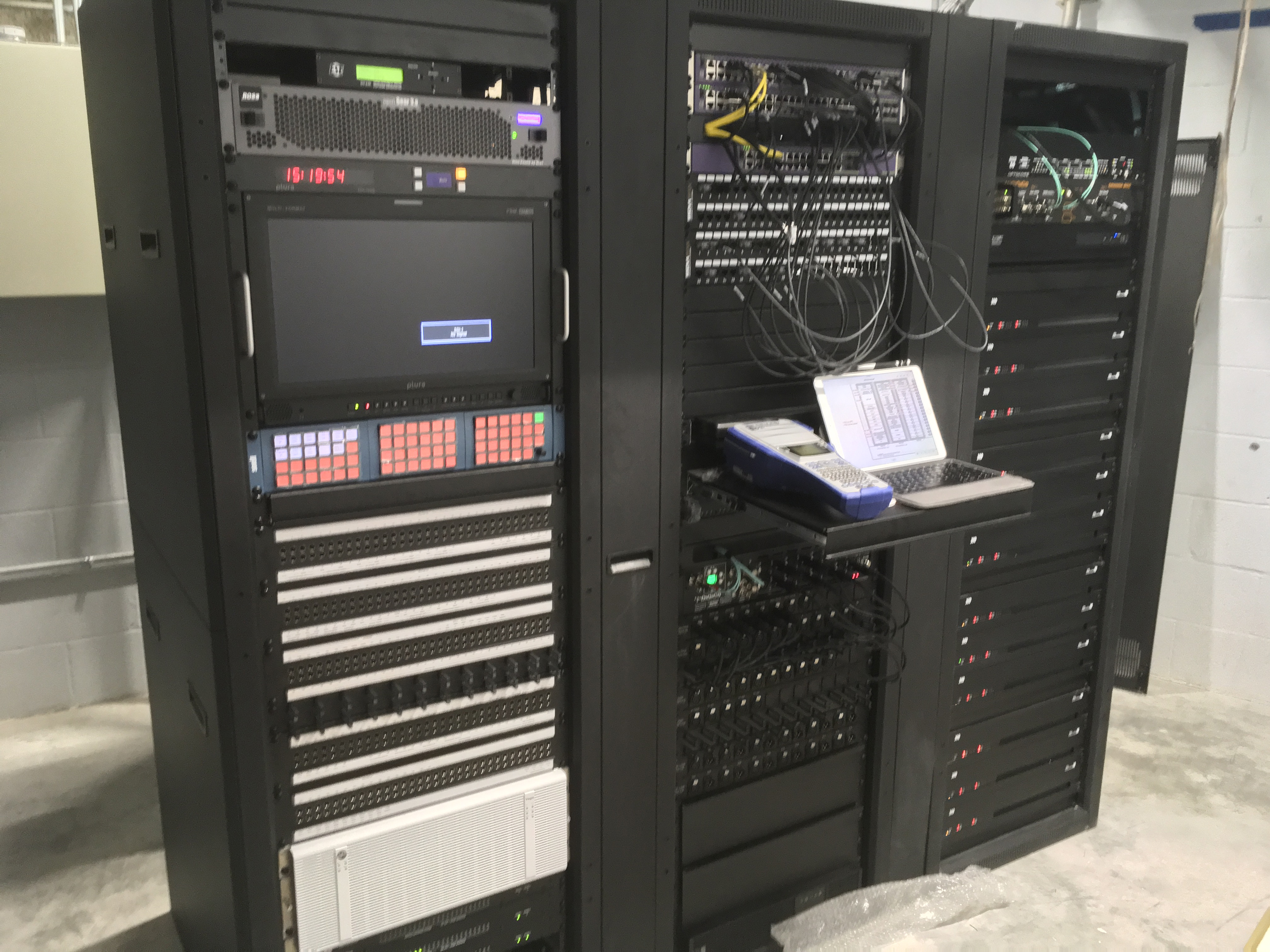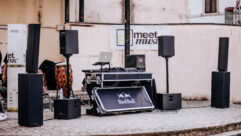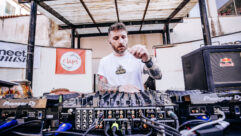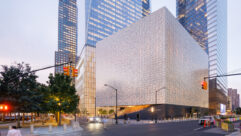On this edition of the SVC Podcast, Contributing Editor Bennett Liles talks with Jordan Lytle of Akustiks about the complete sound system upgrade they designed for the Thelma Gaylord Performing Arts Center in Oklahoma City. Jordan describes the installation of the d&b audiotechnik speaker system, the DiGiCo front of house and monitor mixers and the hearing loop for audience members with hearing disabilities.
Links of Interest:
· Akustiks, designers of concert, drama, multi-use and entertainment performance spaces
· The Oklahoma City Civic Center Music Hall
· Assist2Hear – installation of hearing loops in churches, theaters and other venues
· d&b audiotechnik, providers of the house speaker system
· DiGiCo SD7T front of house sound mixer
This is the SVC Podcast from Sound & Video Contractor Magazine with Jordan Lytle of Akustiks. We’ve got show notes and product links for this and other podcasts at svconline.com. Just go to Podcasts at the top of the page.
The Thelma Gaylord Performing Arts Center in Oklahoma City has hosted a huge variety of shows but the sound system needed to be more flexible so they called in Akustiks in South Norwalk, Connecticut to design an all new one from the ground up. Jordan Lytle was the project manager and he’s here with the whole story on it. Coming up right now on the SVC Podcast.
Jordan, great to have you here for the podcast from Akustiks in South Norwalk, Connecticut.
Yeah, thanks for having me.
We’re going to be talking about the big-scale sound system renovation you directed in the Thelma Gaylord Performing Arts Center at the Oklahoma Civic Center Music Hall. That was a big project even for Akustiks with quite a bit of experience in this so start off with telling us about Akustiks.
Yeah, so Akustiks, we’re a consulting firm that works primarily on concert halls and performing arts centers. And so there’s two sides to our office. One is the acousticians that deal with the room shaping and materials and things like that for the acoustics of a hall. And then the side that I work on is the audio/video side and we design he audio systems and video systems that go into these buildings. [Timestamp: 1:36]
Well, it sounds like for projects like this one you’ve got everything you need there as far as people on both sides of things.
Yeah, that’s kind of the hope is kind of work together; to go back and forth to find something that works well for a particular venue.
And at the Oklahoma City Civic Center Music Hall, from the pictures it looks like this main performance space there is a sizable venue so how did Akustiks come into this project?
Paul Scarborough in our office, who is one of the partners, when he was at a previous firm he was the lead acoustician when they did their big renovation of the whole building back in the late 90’s or early 2000’s. And he’s basically kept in touch with people over there throughout the years and as their sound system started to age, coming up on 18 years old at this point, we’ve kind of gone out there a couple of times to do some checkups and write up some reports for them and develop budgets throughout the years of when they need to start replacing things. And as soon as they started having more and more systems fail on them they took the plunge and did a major upgrade to their entire sound system. [Timestamp: 2:42]
Yeah, you can only patch things so far and then the technology moves on to where you finally just have to rip out all of the old equipment and start over from the basics.
Yeah, exactly. In any kind of city-owned civic center type thing they always try to stretch those systems as long as they can.
Naturally in a place like that they have a lot of different types of performances going on and they needed you to design a system that’s versatile enough to have what any of those may require.
Yeah, and that was one of the major goals is trying to put in a system that was a lot more rider-friendly. They do self-produce a lot of stuff, but they also have a lot of tours coming through; primarily Broadway tours. And more and more they’re getting first national tours so they didn’t have the capabilities in-house that they needed for some of these events. [Timestamp: 3:26]
And you were the sound consultants but you worked with Hairel Enterprises of Conroe, Texas as the actual installation crew on this thing?
Yes, that’s correct. Yes. So we designed and specified everything and then that went out to bid and Hairel was the contractor for the project.
And you’ve worked with them before? I would think that on a project of this size that this isn’t the first time you you’ve worked together.
No, we’d worked with them before, recently on one particular project in San Antonio Texas called the Tobin Center, which was a full renovation and reuse of their existing building. So we liked them, they did really well and we liked working with them so they went on our approved list to bid this job as well. [Timestamp: 4:12]

Big factor on a project of this complexity. Having a known outfit working with you could avoid some critical communication glitches.
Yeah. And one of the big things is this work was always going to go on while they continued to have shows and events throughout the year so it was really important to have someone that we trusted and we knew that was going to work with the client and work with their schedule. And also work with us and, you know, just do a good job and not try to get change orders for every little thing. Because they really worked with a very difficult schedule and they’ve done a great job down there. [Timestamp: 4:43]
How does that venue sound? I mean, every performance hall has its own acoustic environment. This room has almost 2500 seats so how is the sound in there?
One of the resident companies is the symphony there and the symphony is really happy with the sound of the room. And that was one of those things Paul in our office worked with originally. And so it has that sound that they’re really happy with, and with any of this work they were very adamant about nothing get changed about the acoustics of the room. With that said there are a lot of adjustable acoustics that help for when they do those Broadway tours. They do a summer stock there called the Lyric Theater during the summer. So it’s honestly geared a little bit toward symphony as far as how it sounds. It’s a little bit reverberant and that was one of the big challenges in what we needed out of this new system was to try to get a lot more control and especially a lot of low-end control to keep the system really tight. [Timestamp: 5:37]
Yeah. To some extent, even using an active acoustic system, you could put some extra reverberation in but trying to cut down on the reverb time might be a lot more involved.
And we’ve even talked with them about honestly their program and what they do there has changed over the years and they could do with adding some additional absorption to help some of that out. And so they’ve considered that and they’re thinking about doing that in the future. [Timestamp: 5:59]
You can do all the careful planning in the world but when you get into the room, things can happen so what was the first step when you got access to it? Did you have to start by taking a lot of things out of there?
The venue itself did some of that work; so they removed the main speaker clusters. We left most of the existing infrastructure and wiring and cabling and then we actually ended up adding a new equipment room to house all the new amplifiers for the system and some additional equipment and networking equipment. So we did that kind of in a way to try to keep it out of the existing spaces so that they could still operate with what they were continuing to use while Hairel was in there doing their work. It also got us an amp room that was a lot closer to the speakers. [Timestamp: 6:46]
And so for the main house speakers you specified, I believe it was a d&b audiotechnik line array system.
Yes, that’s correct. Yes. It’s a left-center-right mostly V8 – the V Series from d&b – and using their processing, which means that you end up having to have a single amplifier channel for every aux. [Timestamp: 7:04]
Why did you choose that line array system? I take it you were familiar with those from previous projects?
Yeah. We’ve worked with them before and this is probably one of the larger installs of the V Series. We’ve done several d&b systems and one of the things in particular was that processing that it has to really tighten and control the system. It’s not so much steering in the way that you would think of with digitally-steered column speaker, but it is a little bit similar so you’re able to stay off reflective surfaces and things like that and have a really even response across the entire audience plane. [Timestamp: 7:40]

I think part of this project involved the installation of a new hearing loop system for audience members with hearing disabilities. Was that specified in the original project outline or was that something that was installed later?
Yeah, that was actually included in this project and it was a huge undertaking to put a hearing loop in a venue like that for several reasons. 1. Because it’s large. 2. There’s no carpet, really, or anything to hide the wire underneath the seating area. And 3. There’s a lot of concrete and steel so it was a pretty challenging task to try to loop that room, but they were pretty adamant about doing it, which we thought was really great. So we worked with Listen Technologies to design that system and then a local contractor called Assist2Hear did the installation. [Timestamp: 8:30]
You also specified a DiGiCo SD7T mixer for the main house and an SD5 I think for the monitor mix. Was that something that was preferred by the venue sound people?
Matt Anderson, who is the A1 at the venue was pretty adamant about going with a DiGiCo system. A lot of that was about making the venue rider friendly and just looking across and talking to acts that would come through the venue and kind of just asking what they’d like to see there. And the SD7T is one of the most common consoles that came through on all the Broadway tours. [Timestamp: 9:05]
Very popular mixers in performance halls where there’s a wide range of different acts coming in.
Yeah. They have a ton of capabilities and they actually continue to kind of update the console through firmware updates and even some hardware updates to extend those capabilities. So it seems to be a really popular console. And luckily for us and for the venue that we had the budget to be able to get it. [Timestamp: 9:30]
Well you got the right mixers, the right speaker system, the hearing loop installation and in Part 2 we’ll take a look at the Optocore fiber network and the Shure Axient RF mic system that you put in. We’ve been talking to Jordan Lytle of Akustiks in South Norwalk, Connecticut. Thelma Gaylord Performing Arts Center at the Oklahoma City Civic Center Music Hall. Jordan, we’ll see you next week in Part 2.
Thanks, Bennett.
Good to have Jordan Lytle with us from Akustiks. When we get back with Jordan next week he’ll be taking us through the Optocore fiber network that was installed along with the Shure Axient wireless mic system. So get back with us for all of that, on the next SVC Podcast.










